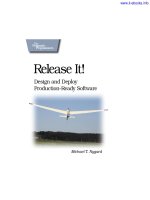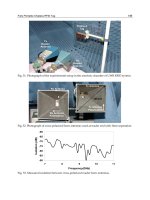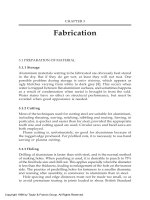Release It!: Design and Deploy Production-Ready Software pot
Bạn đang xem bản rút gọn của tài liệu. Xem và tải ngay bản đầy đủ của tài liệu tại đây (4.09 MB, 350 trang )
www.it-ebooks.info
What readers are saying about Release It!
Agile development emphasizes delivering production-ready code every
iteration. This book finally lays out exactly what this really means for
critical systems today. You have a winner here.
Tom Poppendieck
Poppendieck.LLC
It’s brilliant. Absolutely awesome. This book would’ve saved [Really
Big Company] hundreds of thousands, if not millions, of dollars in a
recent release.
Jared Richardson
Agile Artisans, Inc.
Beware! This excellent package of experience, insights, and patterns
has the potential to highlight all t he mistakes you didn’t know you
have already made. Rejoice! Michael gives you recipes of how you
redeem yourself right now. An invaluable addition to your Pragmatic
bookshelf.
Arun Batchu
Enterprise Architect, netrii LLC
www.it-ebooks.info
Release It!
Design and Deploy Production-Ready Software
Michael T. Nygard
The Pragmatic Bookshelf
Raleigh, North Carolina Dallas, Texas
www.it-ebooks.info
Many of the designations used by manufacturers and sellers to distinguish their prod-
ucts are claimed as trademarks. Where those designations appear in this book, and The
Pragmatic Programmers, LLC was aware of a trademark claim, the designations have
been printed in initial capital letters or in all capitals. The Pragmatic Starter Kit, The
Pragmatic Programmer, Pragmatic Programming, Pragmatic Bookshelf and the linking g
device are trademarks of The Pragmatic Programmers, LLC.
Every precaution was taken in the preparation of this book. However, the publisher
assumes no responsibility for errors or omissions, or for damages that may result fr om
the use of information (including program listings) contained herein.
Our Pragmatic courses, workshops, and other products can help you and your team
create better software and have more fun. For more information, as well as the latest
Pragmatic titles, please visit us at
Copyright
©
2007 Michael T. Nygard.
All rights reserved.
No part of this publication may be reproduced, stored in a retrieval system, or transmit-
ted, in any form, or by any means, electronic, mechanical, photocopying, recording, or
otherwise, without the prior consent of the publisher.
Printed in the United States of America.
ISBN-10: 0-9787392-1-3
ISBN-13: 978-0-9787392-1-8
Printed on acid-free paper with 85% recycled, 30% post-consumer content.
First printing, April 2007
Version: 2007-3-28
www.it-ebooks.info
Contents
Preface 10
Who Should Read This Book? 11
How the Book Is Organized 12
About the Case Studies 13
Acknowledgments 13
Introduction 14
1.1 Aiming for the Right Target 15
1.2 Use the Force 15
1.3 Quality of Life 16
1.4 The Scope of the Challenge 16
1.5 A Million Dollars Here, a Million Dollars There 17
1.6 Pragmatic Architecture 18
Part I—Stability 20
The Exception That Grounded an Airline 21
2.1 The Outage 22
2.2 Consequences 25
2.3 Post-mortem 27
2.4 The Smoking Gun 31
2.5 An Ounce of Prevention? 34
Introducing Stability 35
3.1 Defining Stability 36
3.2 Failure Modes 37
3.3 Cracks Propagate 39
3.4 Chain of Failure 41
3.5 Patterns and Antipatterns 42
www.it-ebooks.info
CONTENTS 6
Stability Antipatterns 44
4.1 Integration Points 46
4.2 Chain Reactions 61
4.3 Cascading Failures 65
4.4 Users 68
4.5 Blocked Threads 81
4.6 Attacks of Self-Denial 88
4.7 Scaling Effects 91
4.8 Unbalanced Capacities 96
4.9 Slow Responses 100
4.10 SLA Inversion 102
4.11 Unbounded Result Sets 106
Stability Patterns 110
5.1 Use Timeouts 111
5.2 Circuit Breaker 115
5.3 Bulkheads 119
5.4 Steady State 124
5.5 Fail Fast 131
5.6 Handshaking 134
5.7 Test Harness 136
5.8 Decoupling Middleware 141
Stability Summary 144
Part II—Capacity 146
Trampled by Your Own Customers 147
7.1 Countdown and Launch 147
7.2 Aiming for QA 148
7.3 Load Testing 152
7.4 Murder by the Masses 155
7.5 The Testing Gap 157
7.6 Aftermath 158
Introducing Capacity 161
8.1 Defining Capacity 161
8.2 Constraints 162
8.3 Interrelations 165
www.it-ebooks.info
CONTENTS 7
8.4 Scalability 165
8.5 Myths About Capacity 166
8.6 Summary 174
Capacity Antipatterns 175
9.1 Resource Pool Contention 176
9.2 Excessive JSP Fragments 180
9.3 AJAX Overkill 182
9.4 Overstaying Sessions 185
9.5 Wasted Space in HTML 187
9.6 The Reload Button 191
9.7 Handcrafted SQL 193
9.8 Database Eutrophication 196
9.9 Integration Point Latency 199
9.10 Cookie Monsters 201
9.11 Summary 203
Capacity Patterns 204
10.1 Pool Connections 206
10.2 Use Caching Carefully 208
10.3 Precompute Content 210
10.4 TunetheGarbageCollector 214
10.5 Summary 217
Part III—General Design Issues 218
Networking 219
11.1 Multihomed Servers 219
11.2 Routing 222
11.3 Virtual IP Addresses 223
Security 226
12.1 The Principle of Least Privilege 226
12.2 Configured Passwords 227
Availability 229
13.1 Gathering Availability Requirements 229
13.2 Documenting Availability R equirements 230
13.3 Load Balancing 232
13.4 Clustering 238
www.it-ebooks.info
CONTENTS 8
Administration 240
14.1 “Does QA Match Production?” 241
14.2 Configuration Files 243
14.3 Start-up and Shutdown 247
14.4 Administrative Interfaces 248
Design Summary 249
Part IV—Operations 251
Phenomenal Cosmic Powers, Itty-Bitty Living Space 252
16.1 Peak Season 252
16.2 Baby’s First Christmas 253
16.3 Taking the Pulse 254
16.4 Thanksgiving Day 256
16.5 Black Friday 256
16.6 Vital Signs 257
16.7 Diagnostic Tests 259
16.8 Call in a Specialist 260
16.9 Compare Treatment Options 262
16.10 Does the Condition Respond to Treatment? 262
16.11 Winding Down 263
Transparency 265
17.1 Perspectives 267
17.2 Designing for Transparency 275
17.3 Enabling Technologies 276
17.4 Logging 276
17.5 Monitoring Systems 283
17.6 Standards, De Jure and De Fact o 289
17.7 Operations Database 299
17.8 Supporting Processes 305
17.9 Summary 309
Adaptation 310
18.1 Adaptation Over Time 310
18.2 Adaptable Software Design 312
18.3 Adaptable Enterprise Architecture 319
18.4 Releases Shouldn’t Hurt 327
18.5 Summary 334
www.it-ebooks.info
CONTENTS 9
Bibliography 336
Index 339
www.it-ebooks.info
Preface
You’ve worked hard on the project for more than year. Finally, it looks
like all the features are actually complete, and most even have unit
tests. You can breathe a sigh of relief. You’re done.
Or are you?
Does “feature complete” mean “production ready”? Is your system really
ready to be deployed? Can it be run by operations staff and f ace the
hordes of real-world users without you? Are you starting to get t hat
sinking feeling that you’ll be faced with late-night emergency phone
calls or pager beeps? It turns out there’s a lot more to development
than just getting all the features in.
Too often, project teams aim to pass QA’s tests, instead of aiming for life
in Production (with a capital P). That is, the bulk of your work probably
focuses on passing testing. But testing—even agile, pragmatic, auto-
mated testing—is not enough to prove that software is ready for the
real world. The stresses and the strains of the real world, with crazy
real users, globe-spanning traffic, and virus-writing mobs from coun-
tries you’ve never even heard of, go well beyond what we could ever
hope to test for.
To make sure your software is ready for the harsh realities of the real
world, you need to be prepared. I’m here to help show you where the
problemslieandwhatyouneedtogetaroundthem.Butbeforewe
begin, there are some popular misconceptions I’ll discuss.
First, you need to accept that fact t hat despite your best laid plans, bad
things will still happen. It’s always good to prevent them when possible,
of course. But it can be downright fatal to assume that you’ve predicted
and eliminated all possible bad events. Instead, you want to take action
and prevent the ones you can but make sure that your system as a
whole can recover from whatever unanticipated, severe traumas might
befall it.
www.it-ebooks.info
WHO SHOULD READ THIS BOOK? 11
Second, realize that “Release 1.0” is not the end of the development
project but the beginning of the system’s life on its own. The situa-
tion is somewhat like having a grown child leave its parents for the
first time. You probably don’t want your adult child to come and move
back in with you, especially with their spouse, four ki ds, two dogs, and
cockatiel.
Similarly, your design decisions made during development will greatly
affect your quality of life after Release 1.0. If you fail to design your
system for a production environment, your life after release will be filled
with “excitement.” And not the good kind of excitement. In this book,
you’ll take a look at the design trade-offs that matter and see how to
make them intelligently.
And finally, despite our collective love of technology, nifty new tech-
niques, and cool systems, in the end you have to face the fact that none
of that really matters. In the world of business—which is the world that
pays us—it all comes down to money. Systems cost money. To make
up for that, they have to generate money, either in direct revenue or
through cost savings. Extra work costs money, but then again, so does
downtime. Inefficient code costs a lot of money, by driving up capital
and operation costs. To understand a running system, you have to fol-
low the money. And to stay in business, you need to make money—or
at least not lose it.
It is my hope that this book can make a difference and can help you and
your organization avoid the huge losses and overspending that typically
characterize enterprise software.
Who Should Read This Book?
I’ve targeted this book at architects, designers, and developers of enter-
prise-class software systems—this includes websites, web services, and
EAI projects, among others. To me, enterprise-class simply means that
the software must be available, or the company loses money. These
might be commerce systems that generate revenue directly through
sales or perhaps critical internal systems that employees use to do their
jobs. If anybody has to go home for the day because your software stops
working, then this book is for you.
www.it-ebooks.info
HOW THE BOOK IS ORGA NIZED 12
How the Book Is Organized
The book is divided i nto four parts, each introduced by a case study.
Part 1 shows you how to keep your systems alive—maintaining system
uptime. Distributed systems, despite pr omises of reliability through
redundancy, exhibit availability more like “two eights” rather than the
coveted “five nines.”
1
Stability is a necessary prerequisite to any other
concerns. If your system falls over and dies every day, nobody is going
to care about any aspects of the far future. Short-term fixes—and short-
term thinking—will dominate in that environment. You’ll have no viable
future without stability, so you’ll start by looking at ways t o ensure
you’ve got a stable base system from which to work.
Once you’ve achieved stability, your next concern is capacity. You’ll
look at that in Part 2, where you’ll see how to measure the capacity
of the system, lear n just what capacity actually means, and learn how
to optimize capacity over time. I’ll show you a number of patterns and
antipatterns to help illustrate good and bad designs and the dramatic
effects they can have on your system’s capacity (and hence, the number
of late-night pager or cell calls you’ll get).
In Part 3, you’ll look at general design issues that architects should con-
sider when creating software for the data center. Hardware and infras-
tructure design has changed significantly over the past ten years; for
example, practices such as multihoming, which were once relatively
rare, are now nearly universal. Networks have grown more complex—
they’re layered and intelligent. Storage area networking is common-
place. Software designs must account for and take advantage of these
changes in order to run smoothly in the data center.
In Part 4, you’ll examine the system’s ongoing life as part of the overall
information ecosystem. Too many production systems are like Schro-
dinger’s cat—locked inside a box, with no way to observe its actual
state. That doesn’t make for a healthy ecosystem. Without informa-
tion, it is impossible to make deliberate improvements.
2
Chapter 17,
Transparency,onpage265 discusses the motives, technologies, and
processes needed to learn from the system in production (which is
the only place you can learn certain lessons). Once the health, per-
formance, and characteristics of the system are revealed, you can act
1. That is, 88% uptime instead of 99.999% uptime.
2. Random guesses might occasionally yield improvements but are more likely to add
entropy than remove it.
www.it-ebooks.info
ABOU T THE CASE STUDIES 13
on that information. And in fact, that’s not optional—you must take
action in the light of new knowledge. Sometimes that’s easier said than
done, and in Chapter 18, Adaptation,onpage310 you’ll look at the
barriers to change and ways to reduce and overcome those b arriers.
About the Case Studies
I have included several extended case studies to illustrate the major
themes of this book. These case studies are taken from real events and
real system failures that I have personally observed. These failures were
very costly—and embarrassing—for those involved. Therefore, I have
obfuscated some information to protect the identities of the companies
and people. I have also changed the names of the systems, classes, and
methods. Only “nonessential” details have been changed, however. In
each case, I have maintained the same industry, sequence of events,
failure mode, error propagation, and outcome. The costs of these fail-
ures are not exaggerated. These are real companies, and this is real
money. I have preserved those figures to underscore the seriousness of
this material. Real money is on the line when systems fail.
Acknowledgments
This book grew out of a talk that I originally presented to the Object
Technology User’s Group.
3
Because of that, I owe thanks to Kyle Lar-
son and Clyde Cutting, who volunteered me for t he talk and accepted
the talk, respectively. Tom and Mary Poppendieck, authors of two fan-
tastic books on “lean software development”
4
have provided invaluable
encouragement. They convinced me that I had a book waiting to get out.
Special thanks also go to my good friend and colleague, Dion Stewart,
who has consistently provided excellent feedback on drafts of this book.
Of course, I would be remiss if I didn’t give my warmest thanks to my
wife and daughters. My youngest girl has seen me working on this for
half of her life. You have all been so patient with my weekends spent
scribbling. Marie, Anne, Elizabeth, Laura, and Sarah, I thank you.
3. See .
4. See Lean Software Development [PP03]andImplementing Lean Software Develop-
ment [MP06].
www.it-ebooks.info
Chapter 1
Introduction
Software design as taught today is terribly incomplete. It talks only
about what systems should do. It doesn’t address t he converse—things
systems should not do. They should not crash, hang, lose data, violate
privacy, lose money, destroy your company, or kill your customers.
In this book, we will examine ways we can architect, design, and build
software—particularly distributed systems—for the muck and tussle of
the real world. We will prepare for the armies of illogical users who do
crazy, unpredictable things. Our software will be under attack from the
moment we r elease it. It needs to stand up to the typhoon winds of a
flash mob, a Slashdotting, or a link on Fark or Digg. We’ll take a hard
look at software that failed the test and find ways to make sure your
software survives contact with the real world.
Software design today resembles automobile design in the early 90s:
disconnected from the real world. Cars designed solely in the cool com-
fort of the lab looked great in models and CAD systems. Perfectly curved
cars gleamed in front of giant fans, purr ing in laminar flow. The design-
ers inhabiting these serene spaces produced designs that were elegant,
sophisticated, clever, fragile, unsatisfying, and ultimately short-lived.
Most software architecture and design happens in equally clean, dis-
tant environs.
You want to own a car designed for the real world. You want a car
designed by somebody who knows that oil changes are always 3,000
miles late; that the t ires must work just as well on the last sixteenth
of an inch of tread as on the first; and that you will certainly, at some
point, stomp on the brakes while you’re holding an Egg McMuffin in
one hand and a cell phone in the other.
www.it-ebooks.info
AIMING FOR THE RIGHT TARGET 15
1.1 Aiming for the Right Target
Most software is designed for the development lab or the testers in the
Quality Assurance (QA) department. It is designed and built to pass
tests such as, “The cust omer’s first and last names are required, but
the middle initial is optional.” It aims to survive the artificial realm of
QA, not the real world of production.
When my system passes QA, can I say with confidence that it is ready
for production? Simply passing QA tells me little about the system’s
suitability f or the next three to ten years of life. It could be the Toy-
ota Camry of software, racking up thousands of hours of continuous
uptime. It could be the Chevy Vega (a car whose front end broke off
on the company’s own test track) or a Ford Pinto, prone to blowing up
when hit in just the right way. It is impossible to tell from a few days or
weeks of testing in QA what the next several years will bring.
Product designers in manufacturing have long pursued “design for
manufacturability”—the engineering approach of designing products
such that they can be manufactured at low cost and high quality.
Prior to this era, product designers and fabricators lived in different
worlds. Designs thrown over the wall to production included screws
that could not be reached, parts that were easily confused, and cus-
tom parts where off-the-shelf components would serve. Inevitably, low
quality and high manufacturing cost followed.
Does this sound familiar? We’re in a similar state today. We end up
falling behind on the new system because we’re constantly taking sup-
port calls from the last half-baked project we shoved out the door. Our
analog of “design for manufacturability” is “design for production.” We
don’t hand designs to fabricators, but we do hand finished software to
IT operations. We need to design individual software systems, and the
whole ecosystem of interdependent systems, to produce low cost and
high quality in operations.
1.2 Use the Force
Your early decisions make the biggest impact on the eventual shape of
your system. The earliest decisions you make can be the hardest ones
to reverse later. These early decisions about the system boundary and
decomposition into subsystems get crystallized into the team structure,
funding allocation, program management structure, and even time-
sheet codes. Team assignments are the first draft of the architecture.
www.it-ebooks.info
QUALITY OF LIFE 16
(See the sidebar on page 150.) It’s a terrible irony that these very early
decisions are also the least informed. This is when your team is most
ignorant of the eventual structure of the software in the beginning, yet
that is when some of the most irrevocable decisions must be made.
Even on “agile” projects,
1
decisions are best made with foresight. It
seems as if the designer must “use the force” to see the future in order
to select the most robust design. Since different alternatives often have
similar implementation costs but radically different lifecycle costs, it is
important to consider the effects of each decision on availability, capac-
ity, and flexibility. I’ll show you the downstream effects of dozens of
design alternatives, with concrete examples of beneficial and harmful
approaches. These examples all come from real systems I’ve worked on.
Most of them cost me sleep at one time or another.
1.3 Quality of Life
Release 1.0 is the beginning of your software’s life, not the end of the
project. Your quality of life after Release 1.0 depends on choices you
make long before that vital milestone.
Whether you wear the support pag er, sel l your labor by the hour, or pay
the invoices for the work, you need to know that you are dealing with a
rugged, Baja-tested, indestructible vehicle that will carry your business
forward, not a fragile shell of fiberglass that spends more time in the
shop than on the road.
1.4 The Scope of the Challenge
The “software crisis” is now more than thirty years old. According to These terms come from
the agile community. The
gold owner is the one
paying for the software.
The goal donor is the one
whose needs you are
trying to fill. These are
seldom the same person.
the gold owners, software still costs too much. (But, see Why Does Soft-
ware Cost So Much? [DeM95] about t hat.) According to the goal donors,
software still takes too long—even though schedules are measured in
months rather than years. Apparently, the supposed productivity gains
from the past thirty years have been illusory.
1. I’ll reveal myself here and now as a strong proponent of agile methods. Their emphasis
on early delivery and incremental improvements means software gets into production
quickly. Since production is the only place to learn how the software will respond to
real-world stimuli, I advocate any approach that begins the learning process as soon as
possible.
www.it-ebooks.info
AMILLION DOLLARS HERE, A MILLION D OLLARS THERE 17
On the other hand, maybe some real productivity gains have gone into
attacking larger problems, rather than producing the same software
faster and cheaper. Over the past ten years, the scope of our systems
expanded by orders of magnitude.
In the easy, laid-back days of client/server systems, a system’s user
base would be measured in the tens or hundreds, with few dozen con-
current users at most. Now, sponsors glibly toss numbers at us such
as “25,000 concurrent users” and “4 million unique visitors a day.”
Uptime demands have increased, too. Whereas the famous “five nines”
(99.999%) uptime was once the province of the mainframe and its care-
takers, even garden-variety commerce sites are now expected to be
available 2 4 by 7 by 365.
2
Clearly, we’ve made tremendous strides even
to consider the scale of software we build today, but with the increased
reach and scale of our systems come new ways to break, more hostile
environments, and less tolerance for defects.
The increasing scope of this challenge—to build software fast that’s
cheap to build, good for users, and cheap to operate—demands con-
tinually improving architecture and design techniques. Designs appro-
priate for small brochureware websites fail outrageously when applied
to thousand-user, transactional, distributed systems, and we’ll look at
some of those outrageous failures.
1.5 A Million Dollars Here, a Million Dollars There
A lot is on the line here: your project’s success, your stock options or
profit sharing, your company’s survival, and even your job. Systems
built for QA often require so much ongoing expense, in the form of
operations cost, downtime, and software maintenance, that they never
reach profitability, let alone net positive cash for the business, which
is reached only after the profits generated by the system pay back the
costs incurred in building it. These systems exhibit low levels of avail-
ability, resulting in direct losses in missed revenue and sometimes even
larger indirect losses through damage to the brand. For many of my
clients, the direct cost of dow ntime exceeds $100,000 per hour.
2. That phrase has always bothered me. As an engineer, I expect it to either be “24 by
365” or be “24 by 7 by 52.”
www.it-ebooks.info
PRAGMATIC ARCHITECTURE 18
In one year the difference between 98% uptime and 99.99% uptime
adds up to more than $17 million.
3
Imagine adding $17 million to the
bottom line just through better design!
During the hectic rush of the development project, you can easily make
decisions that optimize development cost at the expense of operational
cost. This makes sense only in the context of the project team being
measured against a fixed budget and delivery date. In the context of the
organization paying for the software, it’s a bad choice. Systems spend
much more of their life in operation than in development—at least, the
ones that don’t get canceled or scrapped do. Avoiding a one-time cost
by incurring a recurring operational cost makes no sense. In fact, the
opposite decision makes much more financial sense. If you can spend
$5,000 on an automated build and release system that avoids down-
time during releases, the company will avoid $200,000.
4
I think that
most CFOs would not mind authorizing an expenditur e that returns
4,000% ROI.
Don’t avoid one-time
development expenses
at the cost of recurring
operational expenses.
Design and architecture decisions are also
financial decisions. These choices must be
made with an eye toward their implementation
cost as well as their downstream costs. The
fusion of technical and financial viewpoints is
one of the most important recurring themes in
this book.
1.6 Pragmatic Architecture
Two divergent sets of activities both fall under the term architecture.
One type of architecture strives toward higher levels of abstraction that
are more portable across platforms and less connected t o the messy
details of hardware, networks, electrons, and photons. The extreme
form of this approach results in the “ivory tower”—a Kubrickesque
clean room, inhabited by aloof gurus, decorated with boxes and arrows
on every wall. Decrees emerge from the ivory tower and descend upon
the toiling coders. “Use EJB container-managed persistence!” “All UIs
shall be constr ucted with JSF!” “All that is, all that was, and all t hat
3. At an average $100,000 per hour, the cost of downtime for a tier-1 retailer.
4. This assumes $10,000 per release (la bor plus cost of planned downtime), four releases
per year, and a five-year horizon. Most companies would like to do more than four releases
per year, but I’m being conservative.
www.it-ebooks.info
PRAGMATIC ARCHITECTURE 19
shall ever be lives in Oracle!” If you’ve ever gritted your teeth while cod-
ing something according to the “company standards” that would be ten
times easier with some other technology, then you’ve been the victim
of an ivory-tower architect. I guarantee that an architect who doesn’t
bother to listen to the coders on the team doesn’t bother listening to the
users either. You’ve seen the result: users who cheer when the system
crashes, because at least then they can stop using it for a while.
In contrast, another breed of architect rubs shoulders with the coders
and might even be one. This kind of architect does not hesitate to
peel back the lid on an abstraction or to jettison one if it does not
fit. This pragmatic architect is more likely to discuss issues such as
memory usage, CPU requirements, bandwidth needs, and the benefits
and drawbacks of hyperthreading and CPU bon ding.
The ivory-tower architect most enjoys an end-state vision of ringing
crystal perfection, but the pragmatic architect constantly thinks about
the dynamics of change. “How can we do a deployment without reboot-
ing the world?” “What metrics do we need to collect, and how will we
analyze them?” “What part of the system needs improvement the most?”
When the ivory-tower architect is done, the system will not admit any
improvements; each part will be perfectly adapted to its role. Contrast
that to the pragmatic architect’s creation, in which each component is
good enough for the current stresses—and the architect knows which
ones need to be replaced depending on how the stress factors change
over time.
If you’re already a pragmatic architect, then I’ve got chapters full of
powerful ammunition for you. If you’re an ivory-tower architect—and
you haven’t already stopped r eading—then this book might entice you
to descend through a few levels of abstraction to get back in touch with
that vital intersection of software, hardware, and users: living in pro-
duction. You, your users, and your company will all be much happier
when the time comes to finally release it!
www.it-ebooks.info
Part I
Stability
www.it-ebooks.info
Chapter 2
Case Study: The Exception That
Grounded An Airline
Have you ever noticed that the incidents that blow up into the biggest
issues start with something very small? A tiny programming error starts
the snowball rolling downhill. As it gains momentum, the scale of the
problem keeps getting bigger and bigger. A major airline experienced
just such an incident. It eventually stranded thousands of passengers
and cost the company hundreds of thousands of dollars. Here’s how it
happened.
It started with a planned failover on the d atabase cluster that served the
Core Facilities (CF ).
1
The airline was moving toward a service-oriented
architecture, with the usual goals of increasing reuse, decreasing devel-
opment time, and decreasing operational costs. At this time, CF was in
its first generation. The CF team planned a phased rollout, driven by
features. It was a sound plan, and it probably sounds familiar—most
large companies have some variation of this project underway now.
CF handled flight searches—a very common service for any airline
application. Given a date, time, city, airport code, flight number, or any
combination, CF could find and retur n a list of flight details. When this
incident happened, the self-service check-in kiosks, IVR, and “channel
Interactive Voice
Response: the dreaded
telephone menu system
partner” applications had been updated to use CF. Channel partner
applications generate data feeds for big travel-booking sites. IVR and
self-service check-in are both used to put passengers on airplanes—
1. As always, all names, places, and dates are changed to protect the confidentiality of
people and companies involved.
www.it-ebooks.info
THE OUTAGE 22
“butts in seats” in the vernacular. The development schedule had plans
for new releases of the gate agents and call center applications to tran-
sition to CF for flight lookup, but those had not been rolled out yet,
which turned out to be a good thing, as you will soon see.
The architects of CF were well aware of how critical it would be. They
built it for high availability. It ran on a cluster of J2EE application
servers with a redundant Oracle 9i database. All the data was stored
on a large external RAID array with off-site tape backups taken twice
daily and on-disk replicas in a second chassis that were guaranteed to
be at m ost five minutes old.
The Oracle database server would run on one node of the cluster at
a time, with Veritas Cluster Server controlling the database server,
assigning the virtual IP address, and mounting or unmounting filesys-
tems from the RAID array. Up front, a pair of redundant hardware load
balancers directed incoming traffic to one of the application servers.
Calling applications like the self-service check-in kiosks and IVR sys-
tem would connect to the front-end virtual IP address. So far, so good.
If you’ve done any website or web services work, Figure 2.1,onthe
next page probably looks familiar. It is a very common high-availability
architecture, and it’s a good one. CF did not suffer from any of the usual
single-point-of-failure problems. Every piece of hardware was redun-
dant: CPUs, fans, drives, network cards, power supplies, and network
switches. The servers were even split into different racks in case a sin-
gle rack got damaged or destroyed. In fact, a second location thirty
miles away was ready to take o ver in the event of a fire, flood, bomb, or
meteor strike.
2.1 The Outage
As was the case with most of my large clients, a local team of engi-
neers dedicated to the account operated the airline’s infrastructure. In
fact, that team had been doing most of the work for more than three
years when this happened. On the night this started, the local engi-
neers had executed a manual database failover from CF database 1
to CF database 2. (See Figure 2.1, on the following page.) They used
Veritas to migrate the active database from one host to the other. This
allowed them to do some routine maintenance to the first host. Totally
routine. They had done this proceduredozensoftimesinthepast.
www.it-ebooks.info
THE OUTAGE 23
CF App 1 CF App 2 CF App 3 CF App n
Virtual IP Address
SCSI
SCSI
Hardware Load Balancer
Virtual IP Address
CF Database 1 CF Database 2
RAID 5
Array
Heartbeat
Figure 2.1: CF Deployment Architecture
Veritas Cluster Server orchestrates the failover. In the space of one
minute, it can shut down the Oracle server on database 1, unmount the
filesystems from the RAID array, remount them on database 2, start
Oracle there, and reassign the virtual IP address to database 2. The
application servers can’t even tell that anything has changed, because
they are configured to connect to the virtual IP address only.
The client scheduled this particular change for a Thursday evening,
at around 11 p.m., Pacific time. One of the engineers from the local
team worked with the operations center to execute the change. All went
exactly as planned. They migrated the active database from database 1
to database 2 and then updat ed database 1 . After double-checking that
database 1 was updated correctly, they migrated the database back
www.it-ebooks.info
THE OUTAGE 24
to database 1 and applied the same change to database 2. The whole
time, routine site monitoring showed that the applications were contin-
uously available. No downtime was planned for this change, and none
occurred. At about 12:30 a.m., the crew marked the change as “Com-
pleted, Success” and signed off. The local engineer headed for bed, after
working a 22-hour shift. There’s only so long y ou can run on double
espressos, after all.
Nothing unusual occurred until two hours later.
At about 2:30 a.m., all the check-in kiosks went red on the monitoring
console—every single one, everywhere in the country, stopped servicing
requests at the same time. A few minutes later, the IVR servers went
red too. Not exactly panic time, but pretty close, because 2:30 a.m. in
Pacific time is 5:30 a.m. Eastern time, which is prime time for com-
muter flight check-in on the Eastern seaboard. The operations center
immediately opened a Severity 1 case and got the local team on a con-
ference call.
In any incident, my first priority is always to restore service. Restoring
service takes precedence over investigation. If I can collect some data
for post-mortem root cause analysis, that’s great—unless it makes the
outage longer. When the fur flies, improvisation is not your friend. For-
tunately, the team had created scripts long ago to take thread dumps of
all the Java applications and snapshots of the databases. This style of
automated data collection is the perfect balance. It’s not improvised, it
does not prolong an outage, yet it aids post-mortem analysis. According
to procedure, the operations center ran those scripts right away. They
also tried restarting one of the kiosks’ application servers.
The trick to restoring service is figuring out what to target. You can
always “reboot the world” by restarting every single server, layer by
layer. That’s almost always effective, but it takes a long time. Most of
the time, you can find one culprit that is really locking things up. In a
way, it is like a doctor diagnosing a disease. You could treat a patient
for every known disease, but that will be painful, expensive, and slow.
Instead, you want to look at the symptoms the patient shows to fig-
ure out exactly which disease to treat. The trouble is that individual
symptoms aren’t specific enough. Sure, once i n a while, some symptom
points you directly at the fundamental problem, but not usually. Most
of the time, you get symptoms—like a fever—that tell you nothing by
themselves.
www.it-ebooks.info
CONSEQUENCES 25
Hundreds of diseases can cause fevers. To distinguish between possible
causes, you need more information from tests or observations.
In this case, the team was facing two separate sets of applications that
were both completely hung. It happened at almost the same time, close
enough that the difference could just be latency in t he separate moni-
toring tools that the kiosks and IVR applications used. The most obvi-
ous h ypothesis was that both sets of applications depend ed on some
third entity that was in trouble. As you can see from Figure 2.2,onthe
next page, that was a big finger pointing at CF, the only common depen-
dency shared by the kiosks and the IVR system. The fact that CF had
a database failover three hours before this problem also made it highly
suspect. Monitoring hadn’t reported any trouble with CF, though. Log
file scraping did not reveal any problems, and neither did URL probing.
As it turns out, the monitoring application was only hitting a status
page, so it did not really say much about the real health of the CF
application servers. We made a note to fix that error through normal
channels later.
Remember, restoring service was the first priority. This outage was
approaching the one-hour SLA limit, so the team decided to restart
Service-level agreement:
A contract between the
service provide and the
client, usually with
substantial financial
penalties for breaking
the SLA
each of the CF application servers. As soon as they restarted the first
CF application server, the IVR systems began recovering. Once all CF
servers were restarted, IVR was green, but the kiosks still showed red.
On a hunch, the lead engineer decided to restart the kiosks’ own appli-
cation servers. That did the trick; the kiosks and IVR systems were all
showing green on the board.
The total elapsed time for the incident was a little more than three
hours, from 11:30 p.m. to 2:30 a.m. Pacific time.
2.2 Consequences
Three hours might not sound like much, especially when you com-
pare that to some legendary outages. (EBay’s 24-hour outage from 1999
comes to mind, for example.) The impact to the airline lasted a lot longer
than just thr ee hours, though. Airlines don’t staf f enough gate agents
to check everyone in using the old systems. When the kiosks go down,
the airline has to call in agents who are off-shift. Some of them are over
their 40 hours for the week, incurring union-contract overtime (time
and a half). Even the off -shift agents are only human, though. By the
www.it-ebooks.info









